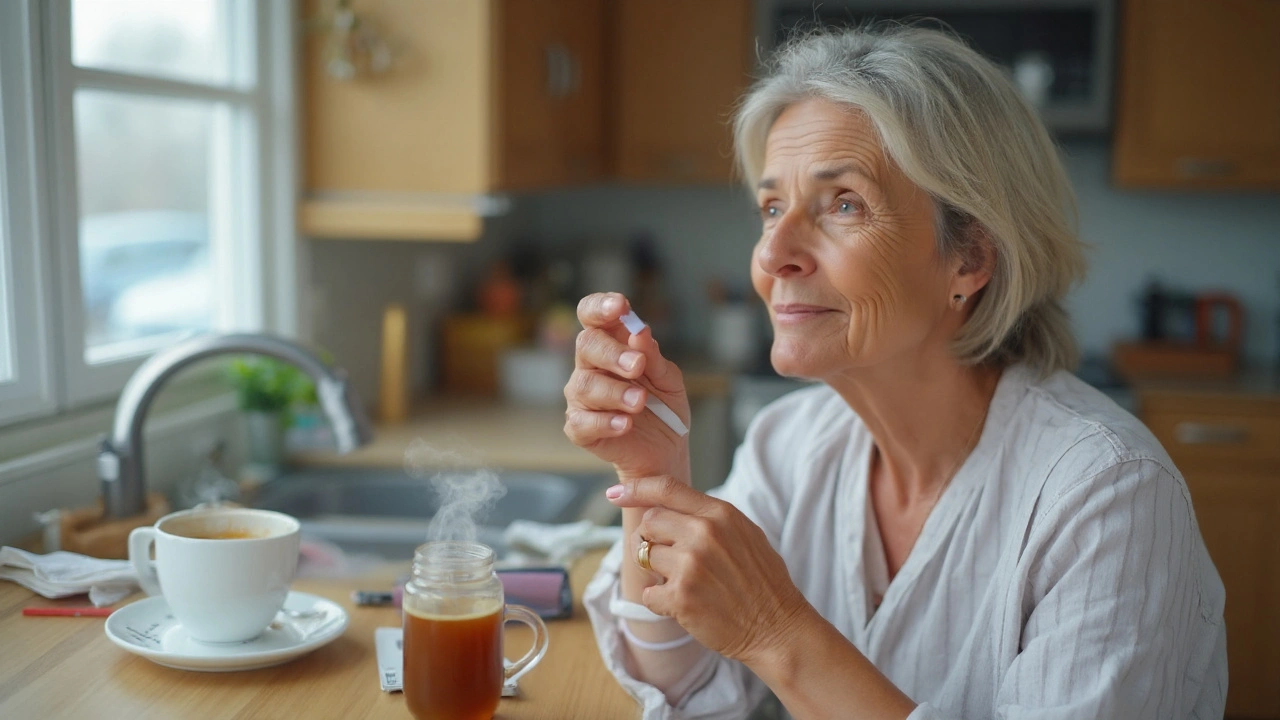
Lurasidone Metabolic Risk Checker
Quick take‑aways
- Lurasidone is a second‑generation antipsychotic approved for schizophrenia and bipolar depression.
- Its metabolic profile is generally milder than drugs like olanzapine, but occasional rises in fasting glucose have been reported.
- Large‑scale trials show lurasidone diabetes link is weak; however, individual susceptibility matters.
- Regular monitoring of HbA1c, weight and fasting plasma glucose is recommended.
- If glucose spikes appear, consider dose adjustment, lifestyle changes, or switching to a lower‑risk antipsychotic.
What is Lurasidone?
Lurasidone is a second‑generation (atypical) antipsychotic that received FDA approval in 2010 for the treatment of schizophrenia and later for bipolar I depression. It belongs to the class of dopamine‑D2 and serotonin‑5‑HT2A antagonists, meaning it blocks specific brain receptors to reduce hallucinations, delusions and mood swings.
The drug is marketed under the brand name Latuda and is available in oral tablets ranging from 7mg to 120mg. Typical maintenance doses fall between 40mg and 80mg daily, taken with food to improve absorption.
How Lurasidone Works
The therapeutic effect stems from two main actions:
- High affinity for dopamine D2 receptors, which dampens the over‑active dopaminergic pathways implicated in psychosis.
- Potent antagonism of serotonin 5‑HT2A and partial agonism at 5‑HT1A receptors, helping to balance mood and cognition.
Because it also interacts with α2‑adrenergic receptors, some patients notice modest improvements in anxiety and cognitive clarity.
Metabolic Side Effects of Antipsychotics
All antipsychotics carry some risk of metabolic disturbance, but the degree varies widely.
Metabolic side effects are undesirable changes in weight, glucose regulation, lipids and blood pressure that can increase cardiovascular risk. Common manifestations include:
- Weight gain (especially visceral fat)
- Elevated fasting plasma glucose (FPG)
- Increased HbA1c levels, indicating poorer long‑term glucose control
- Insulin resistance leading to type 2 diabetes mellitus
High‑risk agents like olanzapine and clozapine often cause >5% weight gain within the first few months, while others such as aripiprazole and lurasidone are considered “metabolically neutral” in most trials.
Evidence Linking Lurasidone to Diabetes
Several data sources help answer the question of whether lurasidone nudges patients toward diabetes.
Randomised Controlled Trials (RCTs)
Across the pivotal PhaseIII studies involving >2,000 participants, the average change in HbA1c for lurasidone was +0.04% (placebo: +0.02%). Fasting glucose rose by roughly 2mg/dL, statistically non‑significant compared with placebo.
In a 12‑month extension trial focusing on metabolic outcomes, only 1.2% of lurasidone‑treated patients met the American Diabetes Association (ADA) criteria for new‑onset diabetes, versus 1.0% on placebo. The absolute risk increase (0.2%) is well within the margin of error.
Observational Real‑World Studies
Pharmacovigilance databases (e.g., FDA Adverse Event Reporting System) have recorded 312 reports of hyperglycaemia linked to lurasidone over a ten‑year span. When adjusted for prescription volume, the reporting odds ratio (ROR) sits at 1.08, indicating a signal barely above background noise.
One large Swedish cohort (n≈7,800) compared incidence of type 2 diabetes among users of lurasidone, risperidone and olanzapine. After five years, diabetes rates were 3.4% for lurasidone, 4.1% for risperidone and 7.9% for olanzapine. The hazard ratio for lurasidone versus olanzapine was 0.43 (95%CI0.31‑0.60), confirming a lower metabolic penalty.
Mechanistic Insights
Animal studies suggest lurasidone has minimal impact on hypothalamic appetite pathways and does not alter hepatic gluconeogenesis. Its modest affinity for histamine H1 receptors-often tied to weight gain-explains the relatively flat weight curve observed in clinics.

Comparing Metabolic Risk Across Common Antipsychotics
| Drug | Average weight gain (kg, 6mo) | Mean HbA1c change (%) | Incidence of new‑onset diabetes (%) |
|---|---|---|---|
| Lurasidone | 0.5-1.0 | +0.04 | 1.2 |
| Risperidone | 1.5-2.0 | +0.12 | 2.3 |
| Olanzapine | 3.5-5.0 | +0.38 | 5.8 |
The table highlights why many clinicians view lurasidone as the “metabolically friendlier” option when treating patients who already have diabetes or are at high cardiovascular risk.
Practical Guidance for Clinicians and Patients
Even a low‑risk drug can tip the balance in a vulnerable individual. Here’s a step‑by‑step checklist to keep glucose under control while on lurasidone:
- Baseline assessment: Record weight, BMI, fasting plasma glucose, and HbA1c before starting therapy. HbA1c is a measure of average blood‑sugar over the previous 2‑3months.
- Quarterly monitoring: Repeat FPG and weight every 12weeks. If HbA1c exceeds 5.7% (pre‑diabetes threshold), increase monitoring frequency.
- Lifestyle reinforcement: Encourage a Mediterranean‑type diet, regular aerobic activity (≥150min/week) and sleep hygiene-these blunt the modest weight gain seen with lurasidone.
- Medication review: If FPG rises >126mg/dL on two separate readings, consider dose reduction or switching to an even lower‑risk agent like ziprasidone.
- Coordinate care: Involve primary‑care physicians or endocrinologists early, especially for patients with existing impaired glucose tolerance.
When a switch is needed, cross‑taper over 2‑4weeks to avoid psychotic relapse. Research from the CATIE trial indicates that abrupt discontinuation raises the risk of symptom rebound, so a gradual approach is safest.
Related Topics to Explore
Understanding the broader picture helps you make informed decisions. Consider reading about:
- Schizophrenia - the primary indication for lurasidone.
- Bipolar depression - another approved use where metabolic safety is crucial.
- Antipsychotic‑induced weight gain - mechanisms and mitigation strategies.
- American Diabetes Association (ADA) guidelines - standards for glucose screening in psychiatric populations.
- FDA pharmacovigilance - how adverse‑event reporting informs safety profiles.
Bottom Line
Lurasidone’s impact on blood‑sugar is modest compared with older atypicals. The scientific evidence does not support a strong causal link to diabetes, but individual risk factors-family history, baseline obesity, concurrent steroids-can amplify any small effect. Regular metabolic monitoring, patient education and a low‑threshold for lifestyle intervention keep the lurasidone diabetes link from becoming a clinical problem.
Frequently Asked Questions
Can lurasidone cause type 2 diabetes?
Large RCTs and real‑world cohorts show only a slight increase in fasting glucose and a marginal rise in new‑onset diabetes (about 0.2% absolute risk). While a direct causal relationship is unlikely, patients with pre‑existing risk factors should be monitored closely.
How often should I check my blood sugar while on lurasidone?
Baseline HbA1c and fasting glucose are essential before starting therapy. Follow‑up labs every 12weeks are recommended for the first six months, then semi‑annually if values remain stable.
Is the weight gain from lurasidone clinically significant?
On average, patients gain less than 1kg in the first six months-far below the 3-5kg often seen with olanzapine. For most people the gain is not clinically concerning, but individual response varies.
Should I switch to another antipsychotic if my blood sugar rises?
First try lifestyle changes and confirm the rise with repeat testing. If FPG stays >126mg/dL or HbA1c exceeds 6.5%, discuss a switch with your psychiatrist-agents like ziprasidone or aripiprazole have an even lower metabolic footprint.
Does the FDA require special warnings for diabetes with lurasidone?
The FDA label mentions metabolic side effects but does not list diabetes as a boxed warning. It advises clinicians to monitor glucose in patients with known risk factors.

Arthur Verdier
September 23, 2025 AT 10:36Oh great, another pharma‑sponsored deep dive that pretends to be a neutral health guide. It’s like they hired a PR firm to write a bedtime story about antipsychotics and sugar. Sure, the numbers look tiny, but have you considered the hidden agenda behind the “metabolically neutral” label? They love to brag about 0.04% HbA1c change while ignoring the millions who end up on insulin anyway. And the whole “take it with food” advice? That’s just a clever way to make us swallow more calories. Let’s not forget the subtle pressure to trust the FDA’s pinky‑promise that everything’s fine. I’ve seen more transparency in a magician’s handbook.
Breanna Mitchell
September 23, 2025 AT 11:10I get why the tone can feel edgy, but the facts in the piece are actually reassuring for many patients. Regular monitoring and lifestyle tweaks can keep blood‑sugar spikes at bay, and that’s a solid plan. It’s encouraging to see that lurasidone isn’t the worst offender when it comes to metabolic side effects. If you’re vigilant with quarterly check‑ups, you’ll catch any drift early. Stay hopeful, and don’t let fear drive medication decisions.
Alice Witland
October 9, 2025 AT 11:53From a cultural perspective, it’s amusing how the conversation around “metabolic neutrality” has become the new buzzword in psychiatric circles. People love to toss around terms like “low‑risk” without acknowledging the diverse dietary habits that vary across regions. While the data on lurasidone is reassuring, we should remember that a British patient’s diet may differ dramatically from an American’s, affecting glucose outcomes. So, let’s keep the dialogue nuanced and avoid one‑size‑fits‑all headlines.
Chris Wiseman
October 9, 2025 AT 12:43Ah, the elegant dance of pharmaceutical optimism and clinical caution! One could argue that the very act of labeling a drug as “metabolically neutral” is itself an exercise in linguistic gymnastics, a subtle sleight of hand that masks the underlying stochastic nature of human physiology. Consider, for a moment, the myriad variables that converge upon a single HbA1c reading: genetics, socioeconomic status, access to nutritious food, even the ambient temperature of a patient’s living environment. Each of these factors can nudge the glucose curve, independent of any pharmacodynamic effect. Furthermore, the notion of “absolute risk” is a construct more suited to actuarial tables than to the lived experience of a person navigating schizophrenia while juggling insurance forms. The data, while statistically robust, inevitably collapses a spectrum of individual trajectories into a single point estimate, thereby erasing the outliers-those whose bodies react dramatically to even the slightest perturbation. In the grand tapestry of mental health treatment, the clinician must weave together this empirical thread with the subjective narratives that patients bring to the consultation. One cannot discount the placebo effect, nor the nocebo effect, which can amplify or dampen metabolic outcomes simply through expectation. Indeed, the very act of monitoring-drawing blood every twelve weeks, charting weight on a spreadsheet-may serve as a behavioral intervention, prompting patients to adopt healthier habits that confound the attribution of causality to the drug itself. So, while the tables and percentages glorify lurasidone’s modest risk profile, the reality remains that medicine is an art as much as a science, requiring a vigilant, compassionate, and critically reflective practitioner to parse the nuance hidden beneath the veneer of clinical trial data.
alan garcia petra
November 1, 2025 AT 15:26Keeping an eye on weight and blood sugar is simple but powerful. If you check your numbers every few months, you’ll notice any changes early and can act fast. Stick to a balanced diet, move a bit each day, and keep those lab appointments. Small moves add up.
Allan Jovero
November 1, 2025 AT 16:50While the sentiment is appreciated, the phrasing "small moves add up" would be more precise as "incremental lifestyle modifications cumulatively improve metabolic outcomes". Additionally, the recommendation to "keep those lab appointments" should reference the appropriate frequency, namely every twelve weeks per current guidelines.